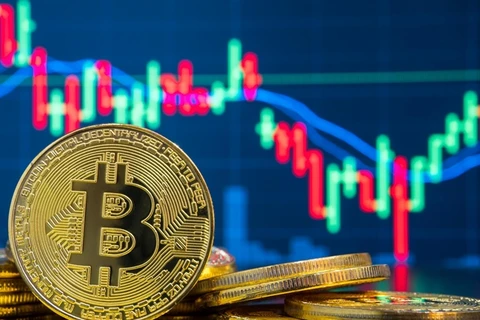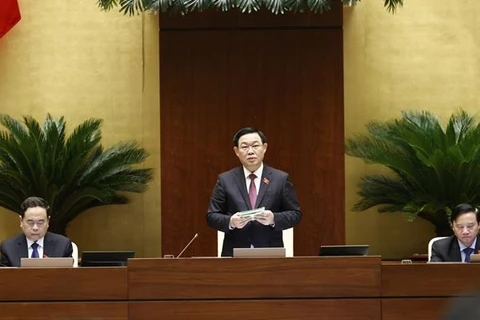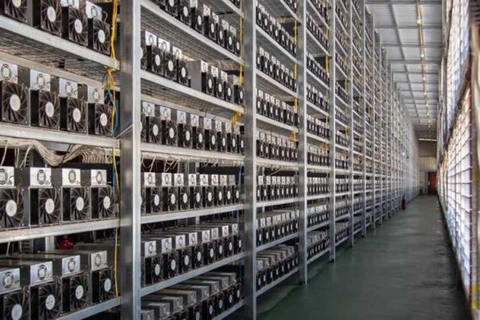Hanoi (VNS/VNA) - The cryptocurrency market in Vietnam remained bleak in 2023, resulting in a lack of profitability for nearly 65% of investors.
Among them, a significant 43.6% of investors experienced losses, according to the Vietnam Crypto Market Report 2023 by Coin98 Insights.
The report was based on a survey conducted in December 2023, involving 1,200 participants.
The report revealed that the majority of crypto investors in Vietnam are men, accounting for 85.3% of the market. The investors were predominantly young, with ages ranging from 18 to 36 years old.
Specifically, 47.1% of investors fell within the 26-36 age bracket, while 37.9% were aged 18-25. Data from OKX and BingX indicated that most individual investors were concentrated in major cities, primarily Ho Chi Minh City (50-54%), Hanoi (25-30%) and Da Nang (3-5%).
In terms of income levels, a significant portion of crypto investors in Vietnam earned between 10 million VND and 25 million VND per month (45.82%), while 26.22% earn less than 10 million VND per month. The report also highlighted that the majority of investors entered the market during the uptrend period of 2020-2022, accounting for 48.7% of participants.
When it comes to investment strategies, centralised exchanges (CEXs) remained the most trusted platforms for storing crypto assets among investors. The second choice was hot wallets or cold wallets. Hot wallets, which were connected to the internet for easier access, were favoured, while cold wallets, which kept crypto keys offline for enhanced security, are also utilised.
Vietnam was recognised as one of the fastest-growing markets, according to OKX Global's assessment. BingX exchange experienced a substantial increase of 138.41% in the number of Vietnamese users, reaching 143,025 users in 2023.
The report emphasised that the market remained gloomy for most of 2023, with nearly 65% of investors failing to generate profits. However, the percentage of investors experiencing losses has decreased compared to 2022 (57.5%).
The challenging market conditions have led investors to adjust their risk appetite, with only 25% regularly utilising leverage. OKX trading floor data reveals that Vietnamese investors generally opt for leverage of 2.5x or higher.
The reasons behind investor losses in 2023 in Vietnam were quite diverse, with two prominent factors accounting for over 66% of the cases: FOMO (Fear of Missing Out) and a lack of careful transaction planning.
Vietnamese investors typically considered multiple aspects before making investment decisions. Instead of relying on a single factor or investment style, they often combined various options to arrive at their final choices.
Most investors in Vietnam preferred to store their assets on centralised exchanges (CEXs) and utilise these exchanges as their primary method for investing, buying/selling, and holding crypto assets. In 2023, new investment trends gaining popularity included Airdrop and Retroactive strategies. Interestingly, Bitcoin (BTC) was not the most invested asset. Instead, tokens from layer 1 and layer 2 Blockchains receive more attention.
Regarding investment strategies in 2024, the report suggests that, in line with the overall market trend, the majority of Vietnamese investors are focusing on AI projects, Blockchain layer 1 and layer 2, NFT and SocialFi projects, rather than DeFi and RWA. Investors hold positive expectations for the market in 2024, with projections of BTC prices surpassing previous peaks. As a result, many plan to increase their allocation to the crypto market in hopes of achieving high profits.
The success or failure of investors was influenced by various factors, as highlighted by a report from Coin98 Insights. Investors who judiciously use leverage at appropriate times tend to have higher profit rates. Conversely, those who regularly employ leverage often experience losses.
The number of years of investor experience was also a significant factor related to investment outcomes in the crypto market. Veteran investors, who participated before 2017 or during the 2017-2020 period, exhibit lower loss rates compared to new investors (from 2022 onwards).
Interestingly, profitable investors often relied on macroeconomic conditions, news and on-chain data for decision-making, whereas unsuccessful investors tended to follow the advice of friends or Key Opinion Leaders (KOLs).
The ratio of crypto asset allocation to the total portfolio also impacts investment results. Data indicated that investors who allocate smaller amounts of capital (less than 10% and 10-30%) tend to have higher loss rates and lower profit rates compared to other groups. This may be attributed to the fact that investors with smaller allocations often do not closely follow the market as compared to those with larger allocations.
Notably, investors who experienced losses in 2023 were more inclined to invest in Memecoins and NFTs, while holding less Bitcoin. This serves as a valuable lesson for investors to exercise caution when dealing with Memecoins and NFTs.
Trends in 2024
Predictions for 2024 varied among three different groups of investors. Investors who broke even or made profits in 2023 displayed higher confidence in Blockchain layer 2, DeFi and RWA (Real World Assets). On the other hand, investors who incurred losses in 2023 showed more faith in Memecoins and AI projects.
Profitable investors are expected to continue focusing on Blockchain layer 1, layer 2, DeFi, RWA and AI projects in 2024.
The Coin98 Insights report acknowledged the challenging year of 2022 and the first half of 2023, which created an overall subdued sentiment in the market. However, by the end of 2023, with the anticipation surrounding the Bitcoin ETF and other factors, the market regained its vibrancy. Many investors believe that a new growth cycle is on the horizon.
Therefore, 2024 is expected to carry forward the momentum from the end of 2023, marked by significant news and events that will impact the entire market, such as the outcomes of the Bitcoin ETF, the Bitcoin Halving and the DenCun upgrade of Ethereum.
However, the report also emphasises the need for investors to remain attentive to macroeconomic factors that can influence the overall economy and the crypto market specifically. Factors such as the US Federal Reserve maintaining high-interest rates, geopolitical tensions, food security and environmental issues should be taken into consideration./.
Among them, a significant 43.6% of investors experienced losses, according to the Vietnam Crypto Market Report 2023 by Coin98 Insights.
The report was based on a survey conducted in December 2023, involving 1,200 participants.
The report revealed that the majority of crypto investors in Vietnam are men, accounting for 85.3% of the market. The investors were predominantly young, with ages ranging from 18 to 36 years old.
Specifically, 47.1% of investors fell within the 26-36 age bracket, while 37.9% were aged 18-25. Data from OKX and BingX indicated that most individual investors were concentrated in major cities, primarily Ho Chi Minh City (50-54%), Hanoi (25-30%) and Da Nang (3-5%).
In terms of income levels, a significant portion of crypto investors in Vietnam earned between 10 million VND and 25 million VND per month (45.82%), while 26.22% earn less than 10 million VND per month. The report also highlighted that the majority of investors entered the market during the uptrend period of 2020-2022, accounting for 48.7% of participants.
When it comes to investment strategies, centralised exchanges (CEXs) remained the most trusted platforms for storing crypto assets among investors. The second choice was hot wallets or cold wallets. Hot wallets, which were connected to the internet for easier access, were favoured, while cold wallets, which kept crypto keys offline for enhanced security, are also utilised.
Vietnam was recognised as one of the fastest-growing markets, according to OKX Global's assessment. BingX exchange experienced a substantial increase of 138.41% in the number of Vietnamese users, reaching 143,025 users in 2023.
The report emphasised that the market remained gloomy for most of 2023, with nearly 65% of investors failing to generate profits. However, the percentage of investors experiencing losses has decreased compared to 2022 (57.5%).
The challenging market conditions have led investors to adjust their risk appetite, with only 25% regularly utilising leverage. OKX trading floor data reveals that Vietnamese investors generally opt for leverage of 2.5x or higher.
The reasons behind investor losses in 2023 in Vietnam were quite diverse, with two prominent factors accounting for over 66% of the cases: FOMO (Fear of Missing Out) and a lack of careful transaction planning.
Vietnamese investors typically considered multiple aspects before making investment decisions. Instead of relying on a single factor or investment style, they often combined various options to arrive at their final choices.
Most investors in Vietnam preferred to store their assets on centralised exchanges (CEXs) and utilise these exchanges as their primary method for investing, buying/selling, and holding crypto assets. In 2023, new investment trends gaining popularity included Airdrop and Retroactive strategies. Interestingly, Bitcoin (BTC) was not the most invested asset. Instead, tokens from layer 1 and layer 2 Blockchains receive more attention.
Regarding investment strategies in 2024, the report suggests that, in line with the overall market trend, the majority of Vietnamese investors are focusing on AI projects, Blockchain layer 1 and layer 2, NFT and SocialFi projects, rather than DeFi and RWA. Investors hold positive expectations for the market in 2024, with projections of BTC prices surpassing previous peaks. As a result, many plan to increase their allocation to the crypto market in hopes of achieving high profits.
The success or failure of investors was influenced by various factors, as highlighted by a report from Coin98 Insights. Investors who judiciously use leverage at appropriate times tend to have higher profit rates. Conversely, those who regularly employ leverage often experience losses.
The number of years of investor experience was also a significant factor related to investment outcomes in the crypto market. Veteran investors, who participated before 2017 or during the 2017-2020 period, exhibit lower loss rates compared to new investors (from 2022 onwards).
Interestingly, profitable investors often relied on macroeconomic conditions, news and on-chain data for decision-making, whereas unsuccessful investors tended to follow the advice of friends or Key Opinion Leaders (KOLs).
The ratio of crypto asset allocation to the total portfolio also impacts investment results. Data indicated that investors who allocate smaller amounts of capital (less than 10% and 10-30%) tend to have higher loss rates and lower profit rates compared to other groups. This may be attributed to the fact that investors with smaller allocations often do not closely follow the market as compared to those with larger allocations.
Notably, investors who experienced losses in 2023 were more inclined to invest in Memecoins and NFTs, while holding less Bitcoin. This serves as a valuable lesson for investors to exercise caution when dealing with Memecoins and NFTs.
Trends in 2024
Predictions for 2024 varied among three different groups of investors. Investors who broke even or made profits in 2023 displayed higher confidence in Blockchain layer 2, DeFi and RWA (Real World Assets). On the other hand, investors who incurred losses in 2023 showed more faith in Memecoins and AI projects.
Profitable investors are expected to continue focusing on Blockchain layer 1, layer 2, DeFi, RWA and AI projects in 2024.
The Coin98 Insights report acknowledged the challenging year of 2022 and the first half of 2023, which created an overall subdued sentiment in the market. However, by the end of 2023, with the anticipation surrounding the Bitcoin ETF and other factors, the market regained its vibrancy. Many investors believe that a new growth cycle is on the horizon.
Therefore, 2024 is expected to carry forward the momentum from the end of 2023, marked by significant news and events that will impact the entire market, such as the outcomes of the Bitcoin ETF, the Bitcoin Halving and the DenCun upgrade of Ethereum.
However, the report also emphasises the need for investors to remain attentive to macroeconomic factors that can influence the overall economy and the crypto market specifically. Factors such as the US Federal Reserve maintaining high-interest rates, geopolitical tensions, food security and environmental issues should be taken into consideration./.
VNA
























